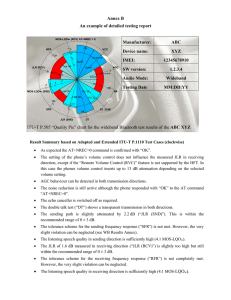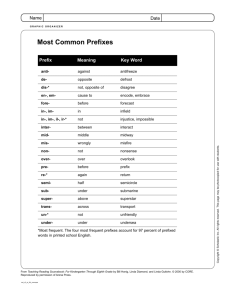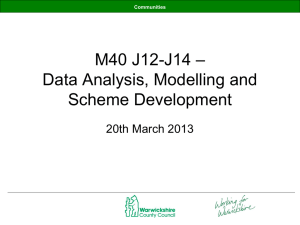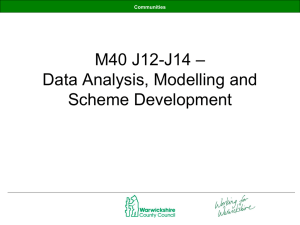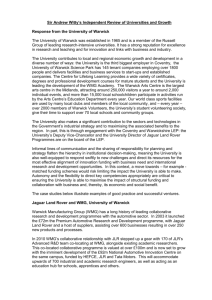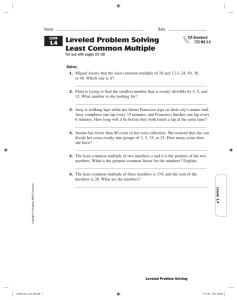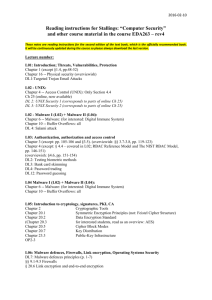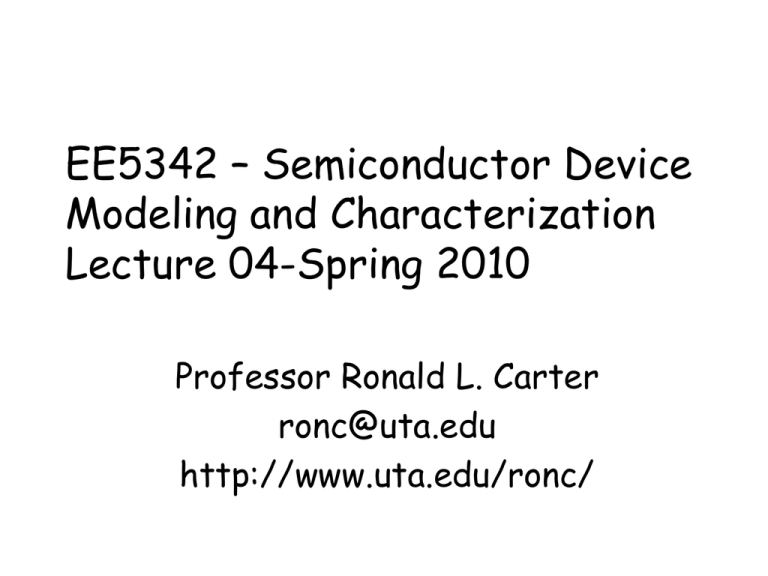
EE5342 – Semiconductor Device
Modeling and Characterization
Lecture 04-Spring 2010
Professor Ronald L. Carter
ronc@uta.edu
http://www.uta.edu/ronc/
First Assignment
• Send e-mail to ronc@uta.edu
– On the subject line, put “5342 e-mail”
– In the body of message include
• Your email address
• Your Name as it appears in the UTA Record no more, no less
• Last four digits of your Student ID: _____
• The name you would like me to use when
speaking to you.
L04 January 27
2
Second Assignment
• e-mail to listserv@listserv.uta.edu
– In the body of the message include
subscribe EE5342
• This will subscribe you to the EE5342
list. Will receive all EE5342 messages
• If you have any questions, send to
ronc@uta.edu, with EE5342 in
subject line.
L04 January 27
3
Drift Current
• The drift current density (A/cm2) is
given by the point form of Ohm’s Law
J = (nqmn+pqmp)(Exi+ Eyj+ Ezk), so
J = (sn + sp)E = sE, where
s = nqmn+pqmp defines the conductivity &
1/s = r defines the resistivity
• The net current is
I J dS
L04 January 27
4
Drift current
resistance
• Given: a semiconductor resistor with
length, l, and cross-section, A. What
is the resistance?
• As stated previously, the
conductivity,
s = nqmn + pqmp
• So the resistivity,
r = 1/s = 1/(nqmn + pqmp)
L04 January 27
5
Drift current
resistance (cont.)
• Consequently, since
R = rl/A
R = (nqmn + pqmp)-1(l/A)
• For n >> p, (an n-type extrinsic s/c)
R = l/(nqmnA)
• For p >> n, (a p-type extrinsic s/c)
R = l/(pqmpA)
L04 January 27
6
Drift current
resistance (cont.)
• Note: for an extrinsic semiconductor
and multiple scattering mechanisms,
since
R = l/(nqmnA) or l/(pqmpA), and
(mn or p total)-1 = S mi-1, then
Rtotal = S Ri (series Rs)
• The individual scattering mechanisms
are: Lattice, ionized impurity, etc.
L04 January 27
7
Exp. mobility model
function for Si1max
min
mn, p mn,
p
Parameter
mmin
mmax
Nref
a
L04 January 27
min
mn, p mn,
p
Nd, a
1
N
ref
As
52.2
1417
9.68e16
0.680
a
P
68.5
1414
9.20e16
0.711
B
44.9
470.5
2.23e17
0.719
8
Electron and hole mobilities in silicon at 300 K as functions of the total dopant
concentration. The values plotted are the results of curve fitting
measurements from several sources. The mobility curves can be generated
using Equation 1.2.10 with the following values of the parameters [3] (see table
on previous slide). Figure 1.16 (p. 31) Device Electronics for Integrated Circuits, 3/E by Richard S. Muller
and Theodore I. Kamins Copyright © 2003 John Wiley & Sons. Inc. All rights reserved.
L04 January 27
9
Carrier mobility
functions (cont.)
• The parameter mmax models 1/tlattice
the thermal collision rate
• The parameters mmin, Nref and a model
1/timpur the impurity collision rate
• The function is approximately of the
ideal theoretical form:
1/mtotal = 1/mthermal + 1/mimpurity
L04 January 27
10
Carrier mobility
functions (ex.)
• Let Nd = 1.78E17/cm3 of
phosphorous, so mmin = 68.5, mmax =
1414, Nref = 9.20e16 and a = 0.711.
Thus mn = 586 cm2/V-s
• Let Na = 5.62E17/cm3 of boron, so
mmin = 44.9, mmax = 470.5, Nref =
9.68e16 and a = 0.680. Thus mn = 189
cm2/V-s
L04 January 27
11
Lattice mobility
• The mlattice is the lattice scattering
mobility due to thermal vibrations
• Simple theory gives mlattice ~ T-3/2
• Experimentally mn,lattice ~ T-n where n
= 2.42 for electrons and 2.2 for holes
• Consequently, the model equation is
mlattice(T) = mlattice(300)(T/300)-n
L04 January 27
12
Ionized impurity
mobility function
• The mimpur is the scattering mobility
due to ionized impurities
• Simple theory gives mimpur ~
T3/2/Nimpur
• Consequently, the model equation is
mimpur(T) = mimpur(300)(T/300)3/2
L04 January 27
13
Mobility Summary
• The concept of mobility introduced as
a response function to the electric
field in establishing a drift current
• Resistivity and conductivity defined
• Model equation def for m(Nd,Na,T)
• Resistivity models developed for
extrinsic and compensated materials
L04 January 27
14
Net silicon (extrinsic) resistivity
• Since
r = s-1 = (nqmn + pqmp)-1
• The net conductivity can be obtained
by using the model equation for the
mobilities as functions of doping
concentrations.
• The model function gives agreement
with the measured s(Nimpur)
L04 January 27
15
Dopant density versus
resistivity at 23°C (296 K)
for silicon doped with
phosphorus and with
boron. The curves can be
used with little error to
represent conditions at
300 K. [W. R. Thurber, R.
L. Mattis, and Y. M. Liu,
National Bureau of
Standards Special
Publication 400–64, 42
(May 1981).]
Figure 1.15 (p. 29) Device
Electronics for Integrated
Circuits, 3/E by Richard S.
Muller and Theodore I. Kamins
Copyright © 2003 John Wiley &
Sons. Inc. All rights reserved.
L04 January 27
16
Net silicon extr
resistivity (cont.)
• Since
r = (nqmn + pqmp)-1, and
mn > mp, (m = qt/m*) we have
rp > rn
• Note that since
1.6(high conc.) < rp/rn < 3(low conc.), so
1.6(high conc.) < mn/mp < 3(low conc.)
L04 January 27
17
Net silicon (compensated) res.
• For an n-type (n >> p) compensated
semiconductor, r = (nqmn)-1
• But now n = N = Nd - Na, and the
mobility must be considered to be
determined by the total ionized
impurity scattering Nd + Na = NI
• Consequently, a good estimate is
r = (nqmn)-1 = [Nqmn(NI)]-1
L04 January 27
18
Equipartition
theorem
• The thermodynamic energy per
degree of freedom is kT/2
Consequently,
1
2
mv
2
vrms
L04 January 27
thermal
3
kT, and
2
3kT
7
10 cm / sec
m*
19
Carrier velocity
1
saturation
• The mobility relationship v = mE is
limited to “low” fields
• v < vth = (3kT/m*)1/2 defines “low”
• v = moE[1+(E/Ec)b]-1/b, mo = v1/Ec for Si
parameter electrons
holes
v1 (cm/s) 1.53E9 T-0.87 1.62E8 T-0.52
Ec (V/cm) 1.01 T1.55
1.24 T1.68
b
2.57E-2 T0.66 0.46 T0.17
L04 January 27
20
vdrift
L04 January 27
[cm/s]
vs. E
[V/cm]
(Sze2, fig. 29a)
21
Carrier velocity
saturation (cont.)
• At 300K, for electrons, mo = v1/Ec
= 1.53E9(300)-0.87/1.01(300)1.55
= 1504 cm2/V-s, the low-field
mobility
• The maximum velocity (300K) is
vsat = moEc
= v1 = 1.53E9 (300)-0.87
= 1.07E7 cm/s
L04 January 27
22
Diffusion of
carriers
• In a gradient of electrons or holes,
p and n are not zero
• Diffusion current,`J =`Jp +`Jn (note
Dp and Dn are diffusion coefficients)
p p
p
Jp qDpp qDp i
j k
z
x y
n
n
n
Jn qDn n qDn i
j k
x y
z
L04 January 27
23
Diffusion of
carriers (cont.)
• Note (p)x has the magnitude of
dp/dx and points in the direction of
increasing p (uphill)
• The diffusion current points in the
direction of decreasing p or n
(downhill) and hence the - sign in the
definition of`Jp and the + sign in the
definition of`Jn
L04 January 27
24
Diffusion of
Carriers (cont.)
L04 January 27
25
Current density
components
Note, since E V
Jp,drift s pE pqm pE pqm pV
Jn,drift snE nqmnE nqmnV
Jp,diffusion qDpp
Jn,diffusion qDnn
L04 January 27
26
Total current
density
The total current density is driven by
the carrier gradients and the potential
gradient
Jtotal Jp,drift Jn,drift Jp,diff. Jn,diff.
Jtotal s p sn V qDpp qDnn
L04 January 27
27
Doping gradient
induced E-field
•
•
•
•
•
If N = Nd-Na = N(x), then so is Ef-Efi
Define f = (Ef-Efi)/q = (kT/q)ln(no/ni)
For equilibrium, Efi = constant, but
for dN/dx not equal to zero,
Ex = -df/dx =- [d(Ef-Efi)/dx](kT/q)
= -(kT/q) d[ln(no/ni)]/dx
= -(kT/q) (1/no)[dno/dx]
= -(kT/q) (1/N)[dN/dx], N > 0
L04 January 27
28
Induced E-field
(continued)
• Let Vt = kT/q, then since
• nopo = ni2 gives no/ni = ni/po
• Ex = - Vt d[ln(no/ni)]/dx
= - Vt d[ln(ni/po)]/dx
= - Vt d[ln(ni/|N|)]/dx, N = -Na < 0
• Ex = - Vt (-1/po)dpo/dx
= Vt(1/po)dpo/dx
= Vt(1/Na)dNa/dx
L04 January 27
29
The Einstein
relationship
• For Ex = - Vt (1/no)dno/dx, and
• Jn,x = nqmnEx + qDn(dn/dx) = 0
• This requires that
nqmn[Vt (1/n)dn/dx] = qDn(dn/dx)
• Which is satisfied if
Dp
Dn kT
Vt , likewise
Vt
mn
q
mp
L04 January 27
30
References
*Fundamentals of Semiconductor Theory and
Device Physics, by Shyh Wang, Prentice Hall, 1989.
**Semiconductor Physics & Devices, by Donald A.
Neamen, 2nd ed., Irwin, Chicago.
M&K = Device Electronics for Integrated Circuits,
3rd ed., by Richard S. Muller, Theodore I. Kamins,
and Mansun Chan, John Wiley and Sons, New York,
2003.
• 1Device Electronics for Integrated Circuits, 2 ed.,
by Muller and Kamins, Wiley, New York, 1986.
• 2Physics of Semiconductor Devices, by S. M. Sze,
Wiley, New York, 1981.
L04 January 27
31

